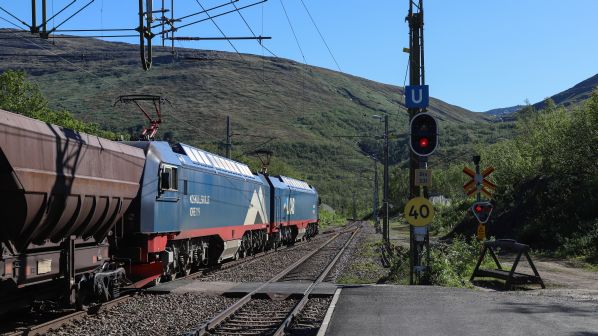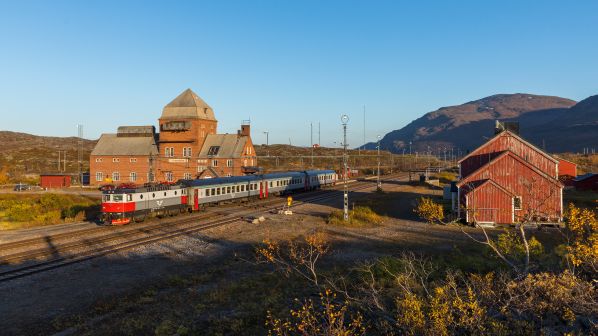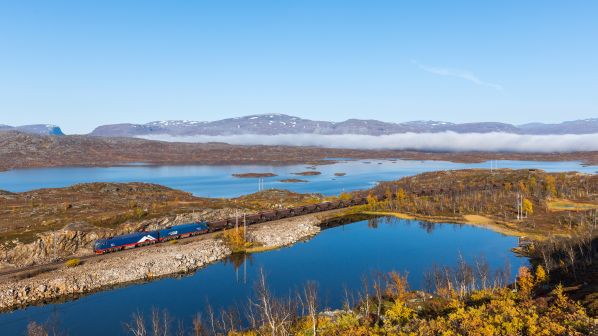LOCATED 2407km from the North Pole, the Norwegian town of Narvik is one of the most northerly ports in the world. The history of this Arctic settlement is intertwined with steel rails and iron ore. In the late 19th century Sweden began to exploit the vast magnetite deposits in the region around what is now the town of Kiruna, 170km to the southeast of Narvik. However, in this endeavour state-owned mining company LKAB faced a logistical challenge.
The railway reached LKAB’s mine at Malmberget in 1888, providing a direct link to the port of Luleå on the Gulf of Bothnia. However, Luleå was not ice-free in winter, and no other Swedish ports were suitable for the export of iron ore originating from Kiruna mine.
The solution was to build a 169km railway from Kiruna to Narvik (then a fishing village) on the shores of the Ofotfjord, a deep natural harbour whose waters are warmed by the Gulf Stream and remain ice-free throughout the winter. The line opened in 1903 and was electrified less than 20 years later.
Between 2012 and 2017, the volume of ore shipped through Narvik rose from 18.9 million tonnes to 19.9 million tonnes.
The Kiruna - Narvik line forms the northern section of the 472km railway known as the Malmbanan (Ore Line) in Sweden and Ofotbanan in Norway. This includes the line from Kiruna to Gällivare, Boden and Luleå as well as the 40km branch from Råtsi to Svappavaara.
Today LKAB’s mines account for around 80% of all iron-ore production in the European Union (EU) and much of that output continues to flow along the Kiruna - Narvik line, which remains a vital link in the company’s logistics chain. On a typical weekday LKAB operates 10 heavy-haul iron-ore trains on the single-track line, with paths for up to 12 trains a day. Another mining company, Kaunis Iron, also operates two trains from Svappavaara to Narvik. Between 2012 and 2017, the volume of ore shipped through Narvik rose from 18.9 million tonnes to 19.9 million tonnes.
In addition to iron-ore traffic, CargoNet and DB Schenker operate intermodal trains from the Fagernes terminal in Narvik, which opened in 2013. With the region’s salmon farms generating increasing volumes of fresh fish and 90% of the groceries consumed in northern Norway arriving in Narvik by rail, intermodal traffic on the route is thriving, with further growth forecast. There are also four passenger trains a day in each direction, including Stockholm - Narvik overnight services.

Alongside its operations on the Kiruna - Narvik line, LKAB typically operates five trains a day on the 210km line from Malmberget to Luleå, where ore is exported to the Baltic region or used for production at the SSAB steelworks. Two thirds of seaborne ore is exported via Narvik, with Luleå handling the remainder. To further optimise transport operations, additives used in ore processing are often carried on the return journey from the port, minimising empty train movements.
Mr Jan Lundgren, LKAB head of department, logistics, says "the company is moving from a corrective maintenance regime towards predict-and-prevent."
Trains move continuously at both the mines and the port with loading/ unloading speeds of 0.15-0.5m/s. Balloon loops eliminate the need for locomotives to run round at the Kiruna and Luleå terminals (but not at Narvik, Svappavaara or Vitåfors), improving utilisation of locomotives and wagons.
LKAB operates 34 5.4MW IORE locomotives supplied by Bombardier and a fleet of more than 1100 Famoo bogie hopper wagons built locally by Kiruna Wagon from 2005 onwards. The wagons are drawbar-connected and operate as married pairs. Traction and rolling stock design has been optimised for operation in extreme winter conditions and to reduce the risk of component damage from snow and ice. Mr Jan Lundgren, LKAB head of department, logistics, says the company is moving from a corrective maintenance regime towards predict-and-prevent.
The intensity of its heavy-haul operations means LKAB accounts for around 49% of all freight moved on Sweden’s national rail network and this proportion looks likely to grow as iron-ore output from the mines of northern Sweden continues to increase.
“Today we have track capacity for all the trains that are scheduled, but we are constrained by the availability of infrastructure,” Lundgren says. “The signalling system is old and relay-based, and with a single-track line any delays transfer to all trains.”

The company’s long-term goals are being set through the LKAB 5.0 strategy. As part of this, Logistics 5.0 will review the entire transport system from mines and railways to the ports in two phases, up to 2030 and after 2030. The focus of Logistics 5.0 is on increasing automation and enhancing energy efficiency, with higher axleloads and track-doubling to increase capacity.
Throughout the Ore Line’s history, a policy of continuous technical development has driven improvements in capacity and performance. This continues today and Swedish infrastructure manager Trafikverket and its Norwegian counterpart Bane Nor are working closely with LKAB, academic institutions and suppliers to optimise infrastructure and operations.
During the 2000s, axleloads were raised from 25 tonnes to 30 tonnes and train lengths increased from 52 to 68 wagons, raising the gross load for a loaded train powered by two locomotives from 5200 tonnes to 8160 tonnes (excluding the locomotives). Passing loops have been extended to approximately 790m to allow two 750m-long trains to pass. Further passing loop extensions are planned at Lappberg and Gammelstad.
The upgrading of the Swedish section of the route has been mirrored with enhancements on the 43km Norwegian stretch, where Bane Nor has extended existing passing loops, added a new passing loop at Djupvik, upgraded the power supply and modernised signalling.
Axleloads are now being increased from 30 to 32.5 tonnes to increase the payload of each wagon from 100 to 110 tonnes. Following a two-year trial, commercial operation of heavier trains began between Vitåfors and Luleå in September 2017.
Survey work for the introduction of 32.5-tonne axleloads on the Kiruna - Narvik line began in mid-2016 and this involved assessment of embankments and all 53 bridges on this stretch. Reinforcement works were undertaken at several locations on the Swedish section during summer 2018. Bane Nor says no reinforcement works were required on the Norwegian section although measures were implemented at Narvik and Straumsnes to accommodate the increased stopping distances of the heavier trains.
Testing of trains with 32.5-tonne axleloads began in December 2018 and on February 18 LKAB operated a test train with a 6684-tonne payload, a new record for the Kiruna - Narvik line.
LKAB has been authorised to operate two trains a day with 32.5-tonne axleloads for the first year of the trial and is upgrading wheelsets on its wagon fleet in preparation for the operation of heavier trains. Norconsult, Sweden, is supporting Trafikverket in the monitoring of infrastructure during the trial phase.
ERTMS
Alongside the axleload trials, Trafikverket is also preparing for resignalling of the Ore Line, which has been prioritised for the rollout of ERTMS.
Trafikverket said in March 2019 that it plans to roll out ERTMS on the Riksgränsen (Norwegian border) - Kiruna - Boden section of the Ore Line in 2021-2022, and on the Boden - Luleå stretch in 2023-2026. At the end of 2018 Trafikverket awarded Bombardier a contract to supply its Interflo 450 ETCS Level 2 solution for the project. The European Union is contributing €44m to the project through the Connecting Europe Facility (CEF).
First-of-class installation of ETCS on the IORE fleet was carried out in 2015 and series fitment of the locomotives with SRS 2.3.0d is currently underway. LKAB is also equipping two T46 diesel locomotives with ETCS.
While heavier axleloads and ETCS will bring welcome additional capacity, Lundgren argues more engineering is required to meet long-term traffic demand. LKAB currently moves around 20 million tonnes of freight on the Ore Line each year and ore volumes are forecast to reach up to 25 million tonnes within a decade, with further growth anticipated in the longer term. LKAB expects to make a decision in the mid-2020s about the development of its underground mine system in Kiruna and this will set the agenda for the role the railway will play in Sweden’s iron ore industry in the 2030s and beyond.
“Output could reach 30-35 million tonnes in the mid-2030s, which is likely to need double track on the entire route.”
“Narvik will be our main port and most of the volume generated by our expansion will go through there,” Lundgren says. “Output could reach 30-35 million tonnes in the mid-2030s, which is likely to need double track on the entire route.”
A joint study by the Swedish and Norwegian infrastructure managers in 2014 concluded that track-doubling of the Kiruna - Narvik line is both necessary and economically viable given projected traffic growth. Trafikverket has launched studies for track-doubling on the Peuravaara - Bergfors and Kopparåsen - Vassijaure sections of the Kiruna - Narvik line encompassing alignment options, capital costs and environmental impact.
However, while planning for track-doubling continues there is considerable uncertainty over how it will be paid for. Sweden’s 2018-2029 National Transport Plan does not include any funding for track-doubling on the Ore Line, much to the frustration of LKAB, which described the plan as “a micro step in the right direction, but far from enough.”
LKAB fears that without a commitment to track-doubling, the Kiruna - Narvik line could become a bottleneck in its logistics chain and potentially threaten its plans for development in northern Sweden. “LKAB doesn’t need increased axleloads on the entire line but an assurance that the line between Kiruna and Narvik will be upgraded to double track,” the firm said in September 2017. “The line is already heavily-trafficked and after 2020 will reach full capacity. This could bring LKAB’s proposals for development to a halt.”
However, detailed capacity analysis by the Royal Institute of Technology (KTH) in Stockholm suggests the line has a significant surplus of unused capacity. “Further capacity increases can be achieved incrementally on single track,” explains Mr Hans Boysen from the KTH Department of Transport Science. “This can be implemented to the same schedule as possible mine expansions. If market demand increases, the infrastructure expansion decisions can be coordinated with actual mine expansions, rather than embarking on track-doubling based on assumptions of future increases in market demand.
“KTH’s analysis has shown how ore transport capacity can be raised incrementally to more than 60 million tonnes a year between Kiruna and Narvik at the same time as increasing intermodal train capacity, still on single track, at a fraction of the cost of track doubling. Incremental capacity expansion would not only raise overall transportation capacity, but would also improve operating efficiency by increasing the payload per train while reducing the train cycle time and thus increasing equipment utilisation.”
Boysen says capacity benefits could be unlocked through relatively modest investments such as increasing tonnage per train with the existing IORE locomotives, raising empty train speeds, and extending and modifying passing loops to enable simultaneous entry. “The total train count is quite low at approximately 32 trains per day on the busier days,” he says. “The need for track doubling is far greater on many other single-track lines in Sweden and Norway, some of which carry more than 80 trains per day.”
Since the elimination of short loops on the Kiruna - Narvik line, capacity utilisation has been classed as ‘medium’ in Trafikverket’s three-tier system.
To improve the efficiency of its rail operation, LKAB is looking at options for automation. “This really starts at the terminals,” Lundgren explains. “We have a vision for the autonomous inspection and loading of trains and we believe this is already technically possible, but we face a regulatory challenge and we have to go through quite rigorous procedures to get these systems approved. We are moving into a digital world and the rules need to be in place to reflect that.”
With the global heavy-haul sector set to convene in Narvik this month for the IHHA 2019 congress and exhibition, Lundgren highlights the continuing need to share best practice in the pursuit of higher technical standards. “We try to follow what’s happening in other countries, where we see great potential for efficiency gains in heavy-haul operations,” he says. “It’s very important to have that common understanding. We can learn a lot from each other.”
Combatting rolling contact fatigue
THE Kiruna - Narvik line is well known for its scenic splendour, but this is one of the toughest places in the world to reliably operate a railway.
Temperatures range from -40°C in the winter, when the region is in darkness for a month-and-a-half, to +25°C in summer. “We have a very short season without snow so most maintenance has to be done in quite a brief period,” says Mr Stefan Kallander, Trafikverket technical specialist for rail maintenance. “There are a lot of things we can’t easily do in cold weather. For example, when the temperature is below -10°C it’s very difficult to execute arc welding.”
Typical maintenance windows are 6-8 hours at night and a summer shutdown in the mines provides an opportunity for more complex tasks. With the intensity of traffic and the unforgiving climate, ensuring a high level of availability is critical and this is reflected in Trafikverket’s approach to maintenance.
From 2006 onwards, all 50kg/m rails on the Kiruna - Riksgränsen section of the line to Narvik were replaced with 60kg/m rails, while sleepers were switched from wood to concrete. Trafikverket is primarily using R350 HT head-hardened rails on the Ore Line, although R320 chromium rail is still used in some locations.
“We are still removing the same amount of material each time, but we’re controlling RCF much more effectively,” says Kallander.
In a bid to combat rolling contact fatigue (RCF), Trafikverket stepped up its rail grinding cycle from once a year for curves to twice a year for sharp curves while continuing with an annual cycle for larger-radius curves. Grinding of rails on straight sections takes place every third year. “We are still removing the same amount of material each time, but we’re controlling RCF much more effectively,” says Kallander.
In 2018 Trafikverket introduced R400 HT rail on the Ore Line with the aim of reducing the wear rate and potentially reducing grinding cycles at high-wear locations.
Trafikverket has been investigating the viability of using a top-of-rail friction modifier (TOR-FM) on the Ore Line to combat RCF. A study by Luleå University of Technology concluded that a wayside TOR-FM system would not be feasible due to high maintenance and operating costs, but an onboard system could be used.
Gauge face lubrication has been introduced for trains entering curves with a radius of less than 600m.

